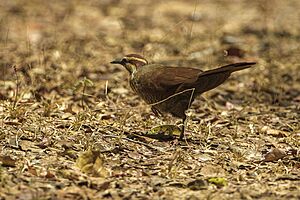White-breasted mesite facts for kids
Quick facts for kids White-breasted mesite |
|
|---|---|
 |
|
| Conservation status | |
| Scientific classification | |
| Genus: |
Mesitornis
|
| Species: |
variegatus
|
The white-breasted mesite (Mesitornis variegatus) is a special bird. It lives only on the island of Madagascar. This bird stays mostly on the ground. It is one of three types of mesites in the Mesitornithidae family. Sadly, there are not many of these birds left. Experts call it a "vulnerable" species. This means it needs our help to survive. You can find it in just a few places in Madagascar.
Contents
What Does the White-breasted Mesite Look Like?
The white-breasted mesite is a medium-sized bird. It spends most of its time on the ground. People often say it looks a bit like a rail bird.
Colors and Markings
This bird has a white face. It has clear markings, like a white stripe above its eye. It also has dark stripes on its cheeks. Its bill is short, dark, and straight.
The top part of its body is a reddish-brown color. Its belly is white. It has a brownish band across its chest. Its lower belly has stripes.
Wings and Song
Its wings are short and round. This bird does not fly much. If it feels chased, it will only fly a few meters. The white-breasted mesite has a beautiful, musical song. It sings early in the morning and during the day.
How the White-breasted Mesite Lives
The white-breasted mesite loves forests. It lives in groups of two to four birds. You can often see them resting or looking for food. They do this on the forest floor during the day.
Finding Food
Their brown feathers help them blend in with the forest. This is called camouflage. They search for food on the ground. They flip over leaves to find small creatures. Their diet includes beetles, centipedes, and spiders. They also eat different kinds of insects like cockroaches, crickets, flies, and moths. Sometimes, they eat seeds too.
Reproduction and Nests
White-breasted mesites usually lay eggs from November to January. They lay one to three white eggs. These eggs have rust-colored spots. Their nests are simple. They are made of twigs woven together. The birds build their nests low to the ground, hidden in plants.
Where Does the White-breasted Mesite Live?
This bird prefers forests that have not been disturbed. These are deciduous forests. It lives in only a few specific places. These are mainly in the north and west of Madagascar. There is also one area in the east called Ambatovaky Reserve.
Specific Locations
The northern and western places include Analamerana Reserve. You can also find them in Ankarafantsika National Park. Other spots are Ankarana Special Reserve, the Daraina forests, and Menabe forest.
Why the White-breasted Mesite Needs Our Help
The number of white-breasted mesites is getting smaller. Experts believe this will continue. This bird is very sensitive to changes in its home. Its forest home is in danger.
Threats to Their Home
People cutting down trees, known as logging, harms their habitat. Forest fires also destroy their homes. Sadly, these birds are also hunted. Because of these threats, the International Union for Conservation of Nature (IUCN) has listed this bird as "vulnerable." This means it is at risk of disappearing if we don't protect it.


